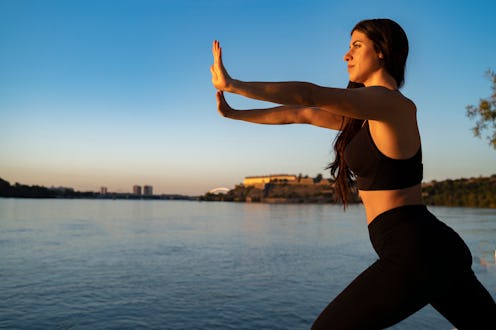Fitness
I Tried Tai Chi, & These Are My Honest Thoughts
This moving meditation is kind of great.

As someone who hunches over technology for a good portion of each day — often holding my breath while I concentrate, type, and text — I knew, logically, that I’d benefit from tai chi. But I didn’t realize how much of a difference it would make until I pulled up a video on YouTube and actually gave it a try.
One afternoon when I was ready to review tai chi, I browsed the Internet and ended up clicking on a five-minute beginner’s class, as it seemed like the obvious place to start for a newbie: not too long, not too short, and hopefully not too complicated. The gist of the flow involved an instructor moving through a sequence of gentle, billowy moves to the tune of soothing music, all the while reminding me to breathe in and breathe out. I lifted my arms up and breathed in, lowered them back down and breathed out, then I “hugged a tree” and “pushed the waves” — all movements or “forms” common to traditional tai chi.
I knew what was coming, to some extent, because I recently interviewed tai chi expert Mike Taylor who told me that tai chi originated as a Chinese martial art and moving meditation, but that it’s also now considered a gentle form of exercise. I remember assuming it’d be on the easier side, as far as workouts go, especially since it’s a common way for older folks to get up and get moving. But let me tell you... there’s much more to it than you might think. Read on for my unfiltered review of tai chi.
What It’s Like To Try Tai Chi
There I was, in my living room, arms outstretched, rocking back and forth from foot to foot. And would you believe I actually felt the burn? There was a definite smolder going on in my shoulders, but in a good way — kind of like how yoga “hurts so good” when you first step onto the mat to work out your stiff muscles.
Not only did it burn, but it also wasn’t as simple as I expected it to be. I definitely blundered my way through a few of the moves to the point I had to take (another) deep breath and remind myself of the instructor’s intro statement. While the movements are based on traditional tai chi forms, the instructor said, you don’t have to do them perfectly in order to reap the benefits. All you have to do is get up and move for five minutes every day. Ah, I thought to myself, feeling relief before I proceeded to rather clumsily flow through postures like “push the water” and “caressing the moon.”
I tried to keep that same mindset in the front of my brain for the meditation aspect of tai chi. Even though the video was only a few minutes long, I still thought about my dog, what I was going to make for lunch, and whether or not it was raining. It brought me back to all the various mindfulness apps I’ve tried over the years that remind you to acknowledge these little thoughts as they float in but to allow them to pass. Tai chi may be a moving meditation, but it’s totally OK — and natural — to think while you do it. It’ll still work.
Will I Do It Again?
Definitely. Just like yoga and meditation, tai chi is something I can see myself adding to my weekly rotation of small ways to feel better and de-stress. It felt really good to pop up from my desk in the middle of the day, take a few deep breaths, and get in a mini stretch-slash-meditation, especially as I was starting to experience writer’s block. I was able to sit back down afterward with a fresh mindset and renewed zest.
Will it replace my usual workout routine? No. I’ll still go to the gym, jog, and do cardio videos to get my heart-pumping sweat on. While I did feel that shoulder burn, tai chi probably isn’t enough for me to count as a workout (though I acknowledge it will be different for everyone depending on their fitness levels). Tai chi does, however, check out as a cool new way to add different types of movement into my life — so I’ll be pushing the waves the next time I need a desk break.
This article was originally published on